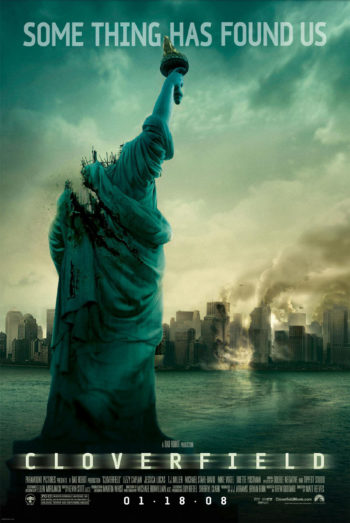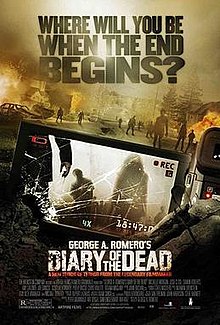Let’s start with THE BLAIR WITCH PROJECT. Surely you remember that 1999 film, a no-budgeter that, due to ecstatic word of mouth and a then-unprecedented internet advertising campaign, became a full-blown phenomenon? Shot entirely in a dark forest with handheld digital cameras, many commentators believed it would usher in lots of similar fare in the years to come.
Well, those years have come and gone. We’ve seen quite a few digitally shot no-budgeters pass our way, though few seemed directly inspired by TBWP (maybe due to the immense backlash that followed in the wake of its success?)—at least until now.
January of 2008 saw the release of CLOVERFIELD, a digitally shot monster mash that used the shaky-cam aesthetic of TBWP in service of a slicker, bigger budgeted horror fest. A month later George Romero’s DIARY OF THE DEAD appeared (although it was actually completed and played the festival circuit in ‘06), another BWP inspired digital freak-out, this one about film students caught up in a zombie holocaust. These films represent the logical evolution of the BLAIR WITCH style, beyond the jerky camerawork and barely glimpsed creatures of that film to a more nuanced and sophisticated aesthetic (Romero has commented that “We thought we were going to be first. As it turns out, we’re part of a trend”).
But there are key differences between CLOVERFIELD and DIARY. One is thoughtful and deliberate while the other is noisy and commercial. One, in my view, is good and one just okay.
Certainly DIARY OF THE DEAD is the more intelligent of the two pictures. That almost goes without saying. George Romero, in his usual fashion, makes some very pertinent political points, while CLOVERFIELD’S creators (including executive producer J.J. Abrams) don’t have much of anything to say beyond the obvious references to 9/11 (in that their film is set in New York City).
 But as to which flick is superior, I’ll have to go with CLOVERFIELD. The fact is it’s more focused, better sustained and overall lots more fun than DIARY, which despite its very real qualities is somewhat quite uneven.
But as to which flick is superior, I’ll have to go with CLOVERFIELD. The fact is it’s more focused, better sustained and overall lots more fun than DIARY, which despite its very real qualities is somewhat quite uneven.
Consider: CLOVERFIELD is an unpretentious, fast-moving rush about a giant monster and the unfortunates in its path. It’s been criticized for being shallow and apolitical, but c’mon: it’s a monster movie, no more, no less—and anyway, DIARY OF THE DEAD is political enough for both movies. George Romero has claimed he works out the sociopolitical themes of his scripts first thing, and then inserts the story and characters. That’s more evident in DIARY than any of his other films, with its excess speechifying about media responsibility and class warfare (“it used to be us against us but now it’s us against them, only they are us”) by individuals who otherwise don’t seem all that erudite or informed. I imagine many of you will find my ranking J.J. Abrams over George Romero downright sacrilegious, not unlike my controversial statement a few years back that THE MATRIX was superior to David Cronenberg’s eXistenZ.
Those who paid attention back in the spring of 1999 (mere weeks, incidentally, before THE BLAIR WITCH PROJECT hit) will recall that THE MATRIX and eXistenZ, similarly themed but otherwise wildly divergent virtual reality thrillers, turned up on US screens at virtually the same time. THE MATRIX of course was a slick and expensive special effects extravaganza while eXistenZ was a thoughtful low budget treatise on the nature of reality.
I like eXistenZ a fair amount, but it just can’t stand up to the original MATRIX. The events of the former film take place inside a video game that people are supposed to want to purchase, but the game’s participants spend most of their time schlepping around a ski lodge plugging animalistic pods into holes in their backs. In the Matrix, on the other hand, people jump, fly, beat the kung fu shit out of each other and blow things up-–I don’t know about you, but that’s the game I’d want to buy!
Put another way, THE MATRIX is good, while eXistenZ is good for you.
This brings us back to CLOVERFIELD and DIARY OF THE DEAD. DIARY is solid, and certainly satisfies the snooty intellectual in me, but the entertainment-craving side will always win out, and it’s that part which CLOVERFILED sates.
I’ll take the argument even further: I believe CLOVERFIELD does far better with the video-within-the-movie angle. Its conceit, that the whole thing consists of footage taken a video camera wielded by a dude who happens to be on the scene when the giant monster shows up, is simple and to-the-point. What’s more, the filmmakers play fair for the most part; the film actually looks like what it pretends to be. The fact that the visuals reportedly made many viewers physically ill testifies to that fact.
DIARY OF THE DEAD takes a more complicated approach. We’re informed at the outset that the film was pieced together from several different sources by one of the participants, who then laid music tracks in over it. Romero can’t be accused of cheating, then, and comes up with some crackerjack sequences. There’s a great moment early on when, after we’ve seen the action entirely from a single viewpoint, a second camera is introduced, resulting in a clever flurry of intercutting between two camera-wielding characters.
The problem is that Romero adds more vantage points as the movie goes on–security cameras, etc.–yet still insists on maintaining the verite illusion. This means every time a new viewpoint is added there’s also an explanation (i.e. scenes of characters uploading images onto a computer despite the fact that their world is collapsing around them) and a lot of lengthy expositional sequences with little-to-no bearing on the main story.
The end result? In the case of CLOVERFIELD, a fun flick that works precisely because of its simplicity; with DIARY OF THE DEAD, another (somewhat) fun film that’s a little too convoluted for its own good. Both, I feel, are worth viewing. So is THE BLAIR WITCH PROJECT, if only to see where these later films got their start.
